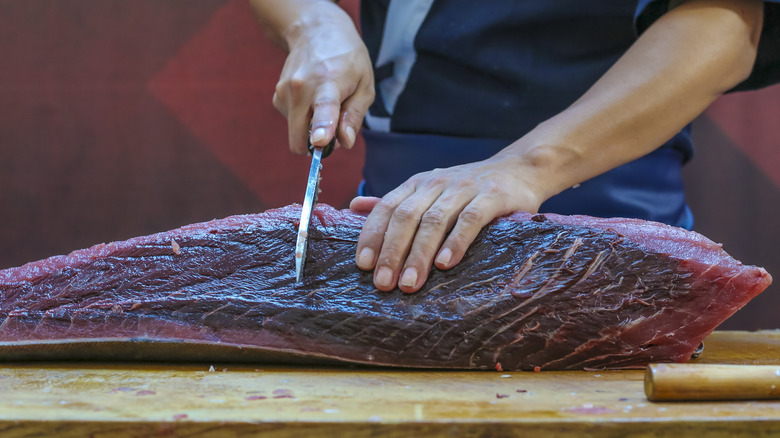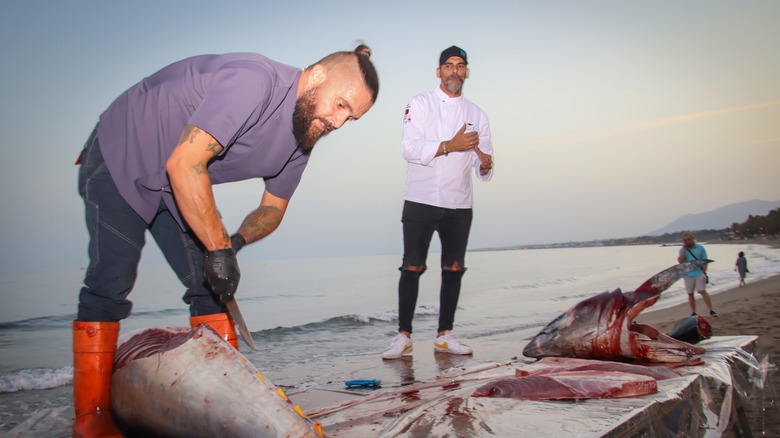The 3,000-Year-Old Origins Of Spain's El Ronqueo Tuna Cutting Ceremony
Not every fish gets its own cutting ceremony. But bluefin tuna lovers across the globe agree this larger-than-life sea creature deserves the honor it receives. From anglers to chefs, seafood processors, fishmongers, and eventual diners, those with a hands-on love for fresh tuna likely understand the pomp and circumstance surrounding the Spanish el ronqueo de atún tuna-cutting ceremony. It begins once a bluefin tuna makes its final journey from sea to land and ultimately to dinner plates across the globe.
Ceremonial fish-cutting isn't exclusive to Spain, with Japan carrying out a similar and elaborate tradition tied to bluefin tuna. The Michelin Guide even covered the 2018 showdown — or showcase — between Spanish and Japanese chefs from Barcelona, with each dissecting a whole bluefin tuna according to their country's cultural tradition. In the ceremonies, every piece of the fish is treasured and kept for good reason.
Bluefin tuna gets praise for its rich flavor, deep-red coloring, and buttery mouth texture, making it ideal for sushi and sashimi meals, per Dinko Seafoods. But bluefins, which are the fattiest of all tunas, also pack a wealth of rich nutrients and health benefits beneath those colorful blue fins and contrasting yellow dorsal fins. Verywell Fit notes that tunas provide beneficial doses of protein, vitamins, and especially heart-healthy omega-3 fatty acids.
What's not to celebrate? That's exactly why Spain's el ronqueo de atún tuna-cutting ceremony has endured for years.
Phoenician traditions endure
To get the perfect edible morsel on a plate, it all begins with thoughtful sourcing. Fortunately, participants in the Spanish el ronqueo de atún tuna-cutting ceremony reach far into the past for a trusted fishing technique, explains Michelin Guide. We're talking at least 3,000 years when Phoenician trap-fishing traditions enabled what we now call "sustainable" practices.
In Spain, those adhering to this "almadraba" fishing method pay close attention to timing, devoting early spring months to catching bluefin tunas migrating to the Mediterranean Sea. This ensures the premium fat content, texture, and flavor that's coveted by bluefin aficionados. The World Wildlife Fund refers to the Mediterranean Sea as the world's most significant bluefin fishery, noting that a single fish can weigh up to 1500 pounds, depending on location and circumstances.
Once fishermen bring a blue-finned beauty ashore, the tuna-cutting ceremony can commence, either on the beach or at any number of locations hosting the lauded celebration. Michelin Guide describes a two-day event at Singapore's FOC Sentosa, a restaurant and beach club inspired by Spanish beach culture. The high-end ceremony includes a Maestro Cortador, aka cutting master, and participating chefs from Michelin-starred restaurants.
El Boquerón Viajero describes the el ronqueo de atún in Costa del Sol, Spain, revealing how the name comes from the sound of the knife cutting the tuna. It imitates a man's "ronquido," or snoring sound, as the fish emerges into edible cuts, including fillets, loin, tuna steaks, and the esteemed belly portions.

